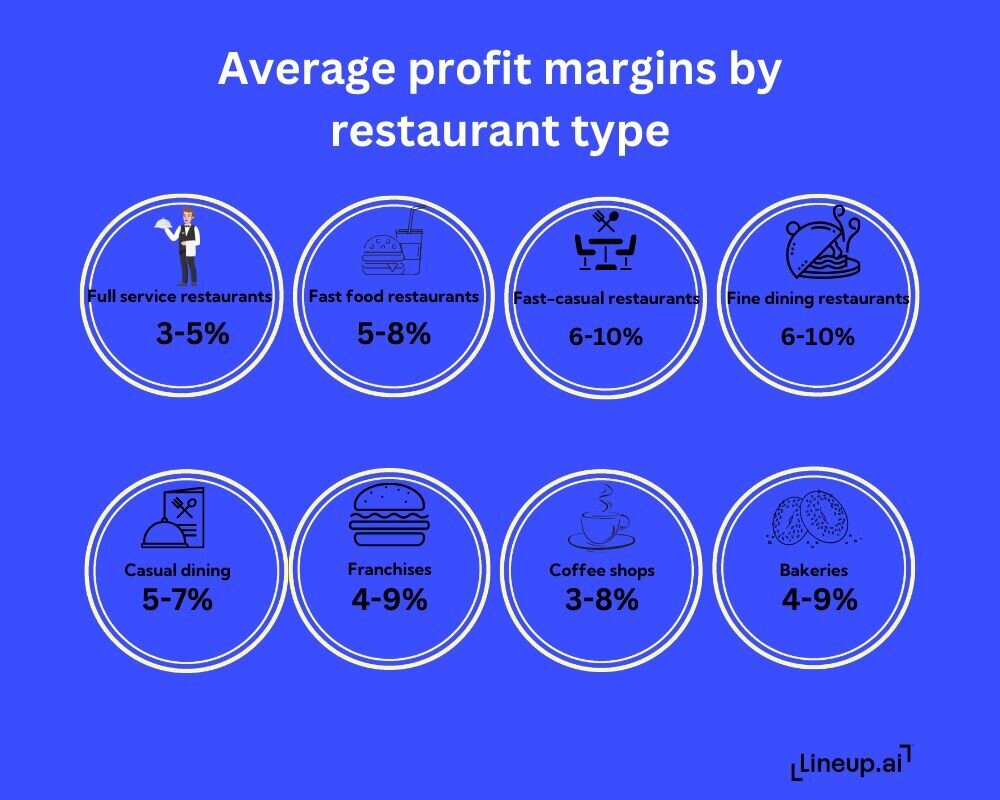Restaurants live and die by their profit margin. From food trucks to full-service restaurants and everything in between, relying on a profit margin formula is crucial in the restaurant industry. When things are going well — restaurant revenue is stable, costs are manageable — your profit margin reflects that.
When things aren’t as great — costs are high or out-of-control, revenue is unpredictable or down — your margin shrinks accordingly.
That’s why it’s so important to calculate your profit margin and track it as time goes on. To simplify this process, try using a restaurant profit margin calculator.
Free Restaurant Profit Margin Calculator
A restaurant profit margin calculator is a tool that can automatically calculate your margins based on a few key factors. It takes into account your restaurant's revenue, costs, and expenses to provide you with an accurate profit margin percentage.
This user-friendly calculator eliminates the need for manual calculations and reduces the chances of errors, so you can quickly assess your financial performance.
How to Use the Calculator
Although this restaurant profit margin calculator is designed to be easy to use, you can use it in the most effective way by following these steps:
Gather Relevant Financial Data
To start using the calculator, gather the necessary financial data from your point-of-sale (POS) system and any record-keeping software. This includes your total revenue, total expenses, fixed and variable costs, and any other relevant expenses. Double-check the accuracy of the numbers to obtain precise results.
Run the Calculation
Once you have this financial data assembled, enter it into the designated fields of the calculator. The calculator will automatically process the information and generate your restaurant's profit margin percentage.
Understanding Restaurant Profit Margins
As you know, profit margins are the percentage of revenue that shows a restaurant's profit after deducting all costs and expenses. It is a key indicator of financial health and efficiency for a restaurant.
The average restaurant profit margin is 3-5%, though depending on the restaurant type, it can range from 0-15%.
It’s important to know that margins will be different for quick-service restaurants and fast food restaurants than for seated dining establishments. So while this is an average, remember to factor in your unique situation.

As you utilize our free restaurant profit margin calculator, it's important to differentiate between two crucial types of profit margins: gross profit margin and net profit margin. These metrics provide deeper insights into your restaurant’s financial dynamics beyond basic profitability.
Gross Profit Margin
This margin is calculated by first determining your Gross Profit, which is simply the revenue minus the cost of goods sold (COGS). Here’s how you can easily compute it: Subtract the cost of goods sold from your total revenue. The result is your gross profit.
Gross Profit = (Revenue - Cost of goods sold)
To then find the gross profit margin, divide the gross profit by the total revenue and multiply by 100 to get a percentage. This margin shows how efficiently a restaurant uses its resources in the kitchen and bar to produce meals and drinks.
Gross Profit Percentage = Gross profit / Total revenue x 100

Net Profit Margin
After determining the gross Profit, the net profit margin considers all other operating expenses, such as rent, utilities, staff wages, and marketing. Here’s the calculation: Subtract total operating costs from the gross profit, and divide the result by total revenue and multiply by 100.
Net Profit Percentage = Gross profit − Total operating costs / Total revenue x 100
This final margin provides a comprehensive view of your overall financial efficiency, taking into account both production costs and operational overheads.
Understanding both margins is essential for making informed decisions that enhance profitability, whether through cost management, pricing adjustments, or operational improvements.
Interpreting Your Calculated Profit Margin Results
Now that you’ve calculated your profit margin, know the industry averages, and understand the factors that go into it, it’s time to interpret your results and understand your restaurant's financial health.
Let's explore a few example scenarios to illustrate what to take from your profit margin results.
Example 1: A High Profit Margin
If the profit margin percentage from the calculator is high or higher than suspected, congratulations! This indicates a good profit margin and that your restaurant generates a healthy profit relative to its total sales. It suggests effective overhead cost management, efficient operations, strong customer demand, and potentially successful pricing strategies.
Example 2: A Low Profit Margin
On the other hand, if the profit margin percentage is low or lower than you had hoped, it suggests that your restaurant is struggling to generate significant profits. This could be due to high costs, pricing strategies that are too low, operational inefficiencies, or unfavorable market conditions.
As you can see, some things are out of your control, such as high inflation that contributes to higher COGS. Other concerns, such as subpar inventory management that can increase food waste and costs, can be tackled by your team. By identifying these issues, you can take corrective measures where possible to improve profitability.
Start Maximizing Your Margins
A restaurant profit margin calculator empowers you to understand and better track your profitability. By analyzing the results of your calculated profit margins, you can identify areas for improvement, optimize costs, and implement effective revenue generation strategies.
Another option would be to utilize restaurant sales forecasting software such as Lineup.ai to better understand what upcoming revenue will look like. This will help you better plan for staffing and reduce unnecessary labor costs.
Restaurant labor forecasting software, for example, can help you easily visualize and track labor cost percentages.

